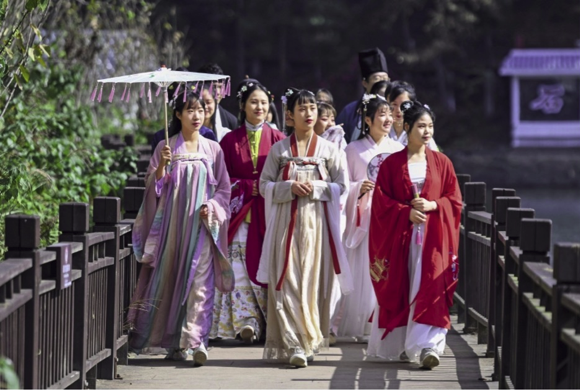Millennials drive Hanfu renaissance

China’s fashion-forward Millennials are driving the Hanfu renaissance; in only one year, the number of Hanfu fans has increased from 3.5 million in 2019 to more than 6 million a year later.
Designs, however, may be purchased from specialized businesses like Shisanyu for anywhere from about $15.50 to over $1,550. Most intriguing, though, is the possibility that modern youth are seeking out local traditions. Currently, videos tagged with #Hanfu have been seen over 48 billion times on China’s TikTok and over 5 billion times on Weibo.
Meanwhile, Shisanyu, a retro-inspired fashion label, has raised over $15.24 million in Series An investment led by Loyal Valley Capital and Bilibili, according to businessoffashion.com. The Shisanyu shop on Alibaba’s Taobao platform alone has amassed 4.1 million followers, making it the most popular Hanfu brand on both Taobao and Tmall.
If you are interested in buying Hanfu dress for yourself then take advantage of the chance to get an exquisitely designed hanfu outfit at a price steal. Pay a visit to New Hanfu at store.newhanfu.com.
Chinese Tradition Revived: Hanfu Fast Becoming a 21st-Century Fashion Statement
Hanfu, which is a generic term for clothing from any period in which the Han Chinese were in power, is regarded in China as a more authentic kind of traditional attire. The most popular fashions are those of the Ming, Song, and Tang dynasties, characterized by long, billowing robes in various stunning colors and adorned with elaborate patterns and needlework.
As a result of the growing Chinese influence globally, there have been many more possibilities to experience Hanfu in countries other than China in the recent decade. Although donning a Hanfu may be challenging because wearing one involves seven stages, Hanfu lovers of today have discovered a way to streamline the procedure by pairing traditional elements with cutting-edge accessories.
The making of Hanfu is not a relic of the past, although it often includes needlework. Depending on the material, it may be manufactured in large quantities using modern methods and sold for a range of prices.
A ma mian qun, a skirt used during the Ming Dynasty for riding, and a jiaoling robe, a top with a round collar, take about a year to construct, a procedure similar to western haute couture.
Controversies on the Hanfu Trend
The hanfu, which has achieved universal acceptability as everyday wear, is incredibly well-liked by young people.
Merchants are putting a modern twist on this traditional garment to appeal to today’s youngsters’ wide range of interests. To create a reflected look, ornamental powders are pressed into the fabric of certain hanfu, giving the garments a rainbow of colors. Modern materials like chiffon are often utilized to make hanfu, while palettes embellish the traditional dress’s surface.
Although many patterns may be seen in hanfu, there is debate about whether they are really traditional. There are often two variations on the classic chest-high, long dress from the Tang Dynasty: the one-piece and the two-piece.
Despite all the arguments, the hanfu circle can agree on Xingzhi.
According to historical accounts, xingzhi refers to the structure and regulations of hanfu. It determines the cut, the vent placement, and other aspects of the hanfu’s aesthetic. Most fans agreed that xingzhi should remain unchanged regardless of the passage of time.
Although traditional, they may also accept novel ideas. As an example, contemporary components are welcome. It is OK to dress in “fairy clothes” or a two-piece dress so long as the wearer is open and honest about the potential issues these garments may pose.
New Hanfu: Bridging the gaps between traditional and modern hanfu
The development of physical and virtual storefronts like New Hanfu is seen as a step toward mainstreaming the Hanfu fashion movement since it currently requires more work to tell different Hanfu companies apart in the crowded online retail space.





